In-situ polymerization ABS modified nylon composite material
An in-situ polymerization and composite material technology, which is applied in the field of in-situ polymerization ABS modified nylon composite materials, can solve the problem that the water absorption and mechanical properties of PA6/ABS alloys cannot be improved at the same time, and achieve enhanced adhesion and reduced size , The effect of improving dispersion
- Summary
- Abstract
- Description
- Claims
- Application Information
AI Technical Summary
Problems solved by technology
Method used
Image
Examples
Embodiment 1
[0019] A kind of preparation method of in-situ polymerized ABS modified nylon composite material, the steps are:
[0020] Lay carbon fiber in the mold at a volume ratio of 50% to 85%, which can be 50%, 68% or 85%, preheat at 140°C to 180°C at 140°C, 162°C or 180°C, and preheat to 90°C ℃~120℃ can be 90℃, 112℃ or 120℃ nitrile rubber, ABS resin, sodium hydroxide, N,N'-bis-(3-(3,5-di-tert-butyl-4-hydroxybenzene Base) propionyl) hexamethylene diamine, (2,4-di-tert-butylphenyl) phosphite triester and caprolactam by mass percentage are nitrile rubber: ABS resin: sodium hydroxide: N, N'-bis-( 3-(3,5-di-tert-butyl-4-hydroxyphenyl)propionyl)hexamethylenediamine:(2,4-di-tert-butylphenyl)phosphite triester:caprolactam=5%~15%:5 % ~ 20%: 0.1% ~ 0.2%: 0.1% ~ 0.5%: 0.1% ~ 0.5%: 100% mixed and injected into the mold, the reaction pressure is 1 atmosphere, and the number average molecular weight of nitrile rubber is 4000 ~ 4400 , the viscosity of the whole system was controlled to 0.02-1Pa.s,...
Embodiment 2
[0022] The steps are the same as in Example 1, wherein the number-average molecular weight of the selected nitrile rubber is 4000 to 4400, and the nitrile rubber accounts for 5%, 10%, and 15% by weight of the monomer, respectively, and the viscosity of the system after being incorporated into the monomer is respectively 0.2 Pa.s, 0.6Pa.s, 1Pa.s, the impregnated fiber is good. The NaOH content accounts for 0.1% and 0.2% of the monomer respectively. The main antioxidant (1098) was 0.1%, 0.25%, 0.5%, and the auxiliary antioxidant (168) was 0.1%, 0.25%, 0.5%, respectively. Using carbon fiber as a reinforcement, determine the hot press molding process, choose 50%, 70%, 85% volume ratio respectively, lay the fiber in the mold and preheat, the temperature is 140 ° C, 160 ° C, 180 ° C respectively. Different monomer formulations were selected and mixed at 90°C and injected into the mold for in-situ polymerization to prepare FRP sheets.
Embodiment 3
[0024] Lay carbon fiber in the mold at a volume ratio of 50% to 85%, which can be 50%, 68% or 85%, and preheat at 140°C, 162°C or 180°C at 140°C to 180°C, and preheat to 90°C ~120°C can be sodium hydroxide at 90°C, 112°C or 120°C, HDI biuret N-75 activator, N,N'-bis-(3-(3,5-di-tert-butyl-4- Hydroxyphenyl) propionyl) hexamethylene diamine, (2,4-di-tert-butylphenyl) phosphite triester and caprolactam are sodium hydroxide by mass percentage: HDI biuret N-75 activator: N, N '-bis-(3-(3,5-di-tert-butyl-4-hydroxyphenyl)propionyl)hexamethylenediamine: (2,4-di-tert-butylphenyl)phosphite triester:caprolactam=0.1% ~0.2%: 0.5% ~ 1.5%: 0.1% ~ 0.5%: 0.1% ~ 0.5%: 100% mixed and injected into the mold, the reaction pressure is 1 atmosphere, the viscosity of the whole system is controlled to 0.02 ~ 0.1Pa.s, in situ After 30 minutes of polymerization reaction, a sheet of in-situ polymerized nylon composite material was prepared.
PUM
| Property | Measurement | Unit |
|---|---|---|
| bending strength | aaaaa | aaaaa |
| flexural modulus | aaaaa | aaaaa |
| shear strength | aaaaa | aaaaa |
Abstract
Description
Claims
Application Information
 Login to View More
Login to View More - Generate Ideas
- Intellectual Property
- Life Sciences
- Materials
- Tech Scout
- Unparalleled Data Quality
- Higher Quality Content
- 60% Fewer Hallucinations
Browse by: Latest US Patents, China's latest patents, Technical Efficacy Thesaurus, Application Domain, Technology Topic, Popular Technical Reports.
© 2025 PatSnap. All rights reserved.Legal|Privacy policy|Modern Slavery Act Transparency Statement|Sitemap|About US| Contact US: help@patsnap.com



